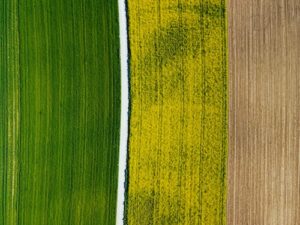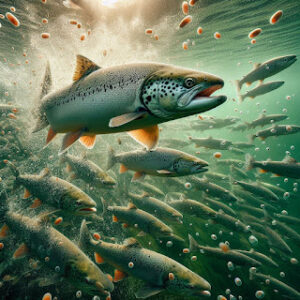Systematic position: (According to Bentham and Hooker)
Division: Phanerogams
Class: Monocotyledonae
Series: Glumaceae
Family: Graminae (Poaceae)
Introduction to Gramineae
- Gramineae or Poaceae is the large and ubiquitous family of monocotyledonous flowering plants.
- It is also known as grass family. This is because they have typically narrow leaves, hollow stems and produce inflorescence known as spikes or panicles.
- It contains nearly 668 genera and 9500 species.
- There are 406 species of 115 genera of this family reported from Nepal.


Distribution of Gramineae
- The plants are cosmopolitan in distribution.
- They are cultivated as food crops throughout the world.
- They are abundant in the grasslands.
Habit and Habitat of Gramineae
- They are usually annual or perennial, herbs or shrubs.
- Sometimes woody tress like branched shrubs (e.g. bamboo).
- Most of the plants are wild while some are cultivated for food and other different purposes.
- They may be hydrophytes, xerophytes, and mesophytes.
Vegetative Characteristics of Gramineae
- Root: Fibrous or tuberous tap root system. Some may have stilt roots such as maize, sorghum etc.
- Stem: Erect, prostrate or even creeping, usually fistular, rarely solid, herbaceous, rarely woody, cylindrical, glabrous, runners or suckers.
- Leaves: radical or cauline, simple, alternate, distichously with two rowed phyllotaxy, sessile, exostipulate, parallel venation, the foliage leaf consisting two parts: leaf sheath and leaf blade. Leaf base forming tubular sheath, sheath open, surrounding internodes incompletely, sheath usually thicker than the blade, margin of sheath is thin and transparent, inner surface glabrous while the upper surface is grooved and hairy. Ligule is present at the junction of the lamina and leaf sheath.
Floral Diagram of Gramineae


Floral Characteristics of Gramineae
- Inflorescence: Recemose type, compound spike which may be stalked or sessile. Each unit of inflorescence is called spikelets which are arranged in various ways on the main axis. A compound spike may be spike of spikelets or panicle of spikelets.
- Flowers: Bracteate, sessile, incomplete, bisexual, rarely unisexual, zygomorphic, hypogynous.
- Perianth: It is represented by broad, thick, fleshy membranous scales called lodicules which are situated above and opposite palea.
- Androecium: Stamens 3 or 6 (3+3), rarely reduced to 2 or 1, polyandrous, filaments long and slender, anther dithecous, versatile, dehisce by longitudinal slits.
- Gynoecium: Monocarpellary; though the pistil is tricarpellary, only one carpel is functional, syncarpous, unilocular with single basal ovule, ovary superior, basal placentation, stigma bifid and feathery, style – present or absent.
- Fruits: Caryopsis, rarely nut.
- Pollination: usually cross anemophilous.
- Seeds: single cotyledon, endospermic.
Floral Formula of Gramineae (Oryza sativa: Rice)
Br. % ⚥ P2 (lodicules) A3+3 G1
Floral Formula of Gramineae Breakdown:
Br. – Bracteate (presence of bracts)
% – Zygomorphic (bilaterally symmetrical)
⚥ – Bisexual flower
P₂ (lodicules) – Perianth represented by 2 lodicules (reduced, scale-like structures)
A₃+₃ – Six stamens in two whorls (3+3), sometimes reduced to 3
G₁ – Monocarpellary gynoecium (functional), ovary superior, unilocular
Identification Characteristics of Gramineae
- The member of this family have a wide range of tolerance feature for climatic changes and can grow on all kinds of habitat.
- Most of the plants in this family are herbs.
- Roots are fibrous type, stilt roots are found in Zea mays (Maize).
- Stem contains short nodes and long internodes.
- Leaves are simple, sessile, exstipulate, alternate with sheathing leaf base, parallel venation.
- Inflorescence spike or spike of spikelets or panicle of spikelets.
- Flowers are minute, incomplete, bisexual or unisexual, zygomorphic, hypogynous, bracteate.
- Perianth absent or represented by 2 to 3 membranous lodicules.
- Stamens polyandrous, anthers dithecous and versatile.
- Gynoecium is monocarpellary with a single basal ovule, basal placentation, style generally 2 to 3 stigma bifid and feathery, and ovary superior.
- Fruits caryopsis.
- Seed endospermic.
Some common plants belonging to Graminae
| Common Name | Botanical Name | Uses / Importance |
|---|---|---|
| Rice | Oryza sativa | Staple food crop in Asia; source of carbohydrates |
| Wheat | Triticum aestivum | Major cereal crop globally; used in bread, pasta, and flour production |
| Maize (Corn) | Zea mays | Food, fodder, and industrial uses; source of corn oil, starch, and biofuel |
| Barley | Hordeum vulgare | Used in malt production, animal feed, and food |
| Sugarcane | Saccharum officinarum | Source of sugar, ethanol, and jaggery |
| Bamboo | Bambusa spp. | Construction, furniture, paper, and ecological restoration |
| Sorghum | Sorghum bicolor | Drought-tolerant crop used for food, fodder, and brewing |
| Millet (Pearl) | Pennisetum glaucum | Nutritious grain used in traditional diets in dry regions |
| Oats | Avena sativa | Used for human consumption (oatmeal), livestock feed |
| Rye | Secale cereale | Used in bread (rye bread), animal feed, and as a cover crop |
Economic Importance of Graminae
- Food: This family includes high food value of cereals such as Oryza sativa, Zea mays, Hordeum vulgare, etc.
- Fodder: The entire aerial green part of several members of Graminae is used as fodder. The straw of some of the cereals such as rice, wheat, barley, etc. used as fodder for cattle.
- Oils: Oils manufactured from leaves of several grass is used in perfume, soap, cream, etc.
- Beverages: Different types of alcoholic beverages are manufactured by using grains of several cereals such as rice, wheat, millet, etc.
- Medicines: Cymbopogon citratus (Lemon grass) has medicinal importance.
- Ornamental purposes: Several species of grass are grown in the lawns for several purposes. They include Cynodon dactylon (Doobo grass), Axonopus affinis (carpet grass), etc.
- Industrial use: Bambusa arundinacea (bamboo) are used in paper making. It is also used in making furnitures, containers, basket, fence and several other purposes.
References
- Keshari A.K, Ghimire K.R, Mishra B.S, Adhikari K.K (2012), A Textbook of Higher Secondary Biology, Vidyarthi Pustak Bhandar, Kathmandu, pp 478-480.
- https://www.biologydiscussion.com/plants/flowering-plants/order-graminales-family-gramineae-the-monocotyledones/19852
- https://mgcub.ac.in/pdf/material/20200408083631afcd50e1f8.pdf
- https://www.inaturalist.org/taxa/47434-Poaceae
- https://onlinesciencenotes.com/characteristic-features-economic-importance-family-gramineae/
- https://gobotany.nativeplanttrust.org/family/poaceae/
- https://agriculturistmusa.com/cucurbitaceae-gramineae-solanaceae/
- https://aerobiologia.cat/pia/general/pdf/fitxes/en/Botanical_Factsheet_SCAIC-PIA_2022_Grasses.pdf
- https://keys.lucidcentral.org/keys/v3/AusGrass/key/AusGrass/Media/Html/GENINFO/importance.html



